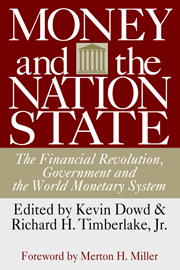Over the past two decades, the International Monetary Fund has promised cheap loans to foreign governments in order to bribe them into pursuing suicidal economic policies designed by IMF technocrats, rather than by their own elected representatives. This costly global meddling was supposed to make the world economy a safer, more stable place.
Needless to say, it has not. Yet international crises that the IMF neither foresaw nor forestalled have been used to persuade Congress to send the IMF another $18 billion.
Congressional Republicans added some "transparency" conditions: the IMF will publish summaries of some decisions and deals. And there will be a commission to study the IMF. But Congress backed away from trying to impose requirements that borrowing countries reduce trade barriers and end political favoritism in lending, or that they repay loans within 18 months at a relatively high interest rate.
Even these abandoned reforms would have been toothless. The U.S. has 1 vote out of 182 in the IMF. The Treasury Department exerts considerable influence over IMF policy, but that is neither a source of comfort nor something Congress can control.
In any case, Congress appears to have focused on two relatively mild criticisms of the fund: moral hazard and lack of transparency.
"Moral hazard" means that bailouts of bad loans encourage more bad loans. Proposals to make IMF loans shorter-term and more expensive are designed to alleviate it. But if the IMF is to become more cautious and restrictive in its lending, it doesn’t need more money: money repaid by one country will become available to loan to another. On the other hand, another $18 billion from the U.S., and $72 billion from other countries, ensure that the outstanding volume of IMF loans will greatly increase— and so will moral hazard.
The transparency problem is that the IMF never reveals the strings it attaches to loans. Congress supposes that if the IMF published sanitized reports on what it had been doing three months earlier, this would somehow improve the quality of the demands it places on its wards. This notion is remarkably innocent. The IMF has 2,300 experts who can rationalize any sort of mischief, and in ways that would make Alan Greenspan’s remarks appear simple and clear by comparison.
A far more serious problem is the IMF’s long history of doing much harm and no good. (For more details see my lengthy study, "The IMF’s Destructive Recipe: Rising Tax Rates and Falling Currencies," in Money and the Nation State, edited by Kevin Dowd and Richard Timberlake and published by the Independent Institute. The IMF nearly always requires countries to devalue their currencies or raise tax rates or both. The IMF has also favored wage controls, and at least condoned higher tariffs. This sort of IMF formula was first applied to Peru and Jamaica in 1978, where real income per capita subsequently fell by 13 to 14 per cent. The next such adjustment programs were in Nicaragua and Bolivia after 1980, where real output subsequently fell by 13 and 28 per cent respectively. A more recent example was Haiti, where a 1990 IMF program (described by the World Bank as an effort to increase fiscal revenues") was followed by a prolonged 24 per cent drop in GDP.
THE CASUALTY LIST
Any list of countries "helped" by IMF programs reads like a casualty list. The start of the IMF’s painful involvement in Yugoslavia was candidly described in the 1989 issue of the World Bank’s publication, Trends in Developing Countries: "The dinar was devalued in real terms by 19.3 per cent and strict limits were imposed on the growth of nominal wages....The program was supported by the IMF.... Output declined about 2 per cent, and inflation accelerated to 251 per cent by the end of the year. The unemployment rate has been rising, and the real income of the population declined by at least 2 percent."
The same sort of destabilization program was pawned off on several Latin American countries. To obtain a two-year IMF loan in 1982-83, for example, Chile deeply devalued the peso, raised tariffs from 10 percent to 35 percent, and raised income-tax rates. The economy collapsed, and inflation soared. Chile completely reversed those policies in 1984-85, and later ended an onerous payroll tax by privatizing Social Security. Since escaping the clutches of the IMF, Chile has become a model for development.
The IMF’s track record in East Asia is no better. South Korea adopted an IMF program in 1980, including a 17 percent devaluation and a huge increase in the highest income-tax rates. The economy shrank by 5 per cent, and inflation hit 35 per cent. As soon as the term of the IMF loan ended in February 1981, the Korean government began to slash tariffs and tax rates. This was followed by nearly two decades of astonishing economic growth, an achievement tarnished but not undone by Korea’s latest disastrous experiment with currency devaluation.







